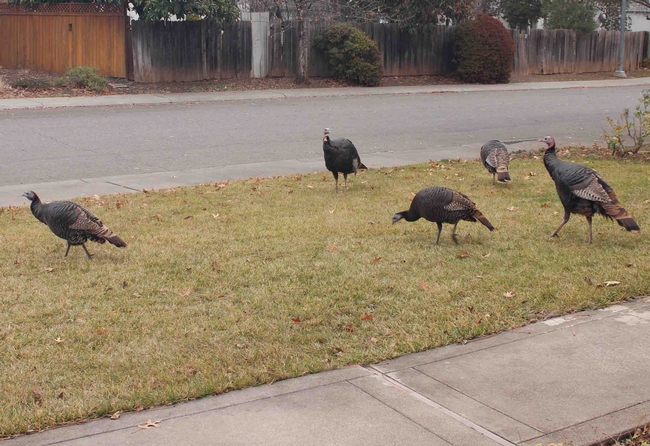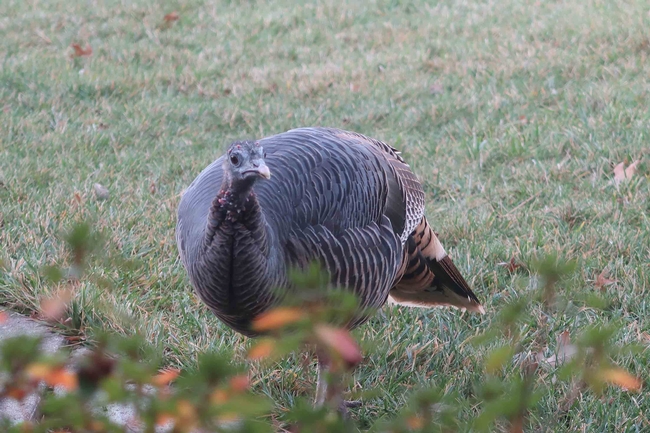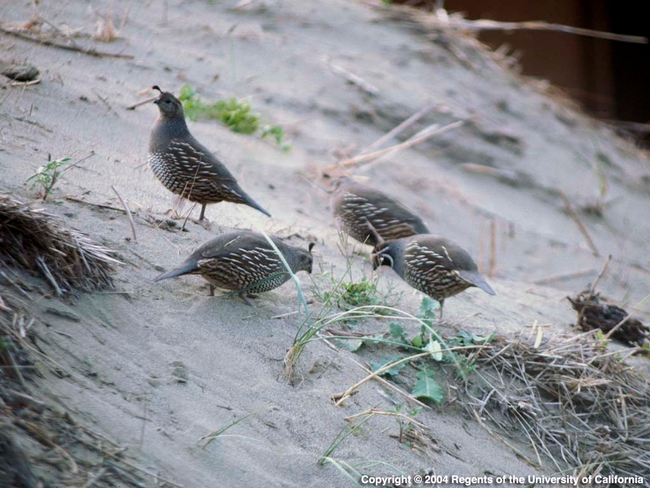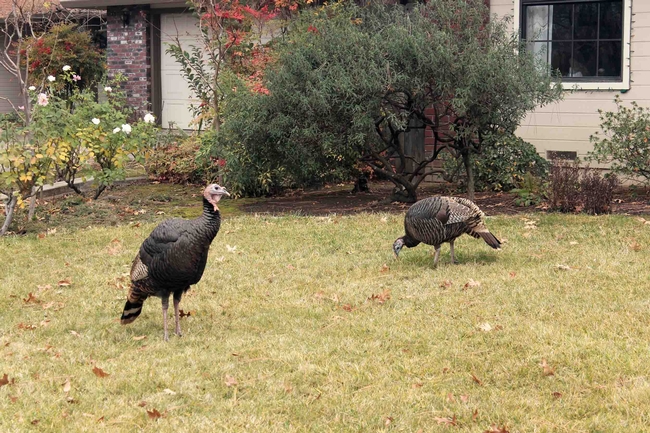Loss of natural habitat is a serious threat to wildlife. How game birds have managed to recover after the wildfires that have roared through and incinerated our neck of the woods is a mystery, but they are again thriving in my part of Paradise. The quail are beginning to nest in protected spaces, and their distinctive call can be heard in the early morning hours. Another seemingly resilient bird is California's wild turkey. While renting in Chico after the Camp Fire, I saw several turkeys around the south side of Chico. Imagine my surprise when I ran head on into one while on a walk on North Avenue, just a few blocks east of McManus School. It is apparent that wild turkeys are quite comfortable moving into urban areas.

Wild turkey (Meleagris gallopavo) was nearly extinct by the 1930's due to overhunting and deforestation that destroyed their natural habitat. Today their population has increased dramatically: wild turkeys can be found throughout North America from Canada to Mexico, numbering an estimated seven million birds. California's wild turkeys now occupy roughly 18 % of our state and are controlled through hunting. While wild turkeys can be found throughout the state, Northern California is home to the largest population.The most common species seen in the Sacramento Valley foothills is the Rio Grande wild turkey, identified by the buff-colored tips on its tail.

People either love or hate the presence of wild turkeys on their property. An adult turkey can weigh upwards of twenty pounds and can cause a lot of damage by roosting on cars, leaving droppings on sidewalks and driveways, and rooting in vegetable and flower gardens. Turkeys are easily domesticated and adapt effortlessly to the human environment where foraging is plentiful. Since turkey eggs hatch in just 28 days, a flock of wild turkeys can arise in a short period of time. There are strategies for humanely encouraging wild turkeys to move to a new neighborhood. Consider using motion detection sprinklers, removing bird feeders from areas where turkeys feed, removing pet kibble from an outside location, and letting Fido roam free in the yard. These tactics will frighten turkeys and encourage them to move on. During breeding season, turkeys can become aggressive. It's best to keep your distance.
California wild turkey season opens March 26 and runs through May 1. The limit is one bird per hunter per day, three per season; a hunting license and Upland Game Bird Validation are required.
Fun Facts:
- Diet: turkeys are omnivores and eat grasses, grains, and berries, as well as snails, slugs, lizards, grasshoppers, caterpillars, spiders, and baby rattlesnakes.
- Average life span: three to five years in the wild. The oldest known wild turkey lived to be about 13 years old.
- Threats: racoon, fox, bear, opossum, hawks, wild cats, humans.
- Nighttime habits: turkeys can be found sleeping in trees.
- Wild turkeys can fly, and they have a top speed in flight of about 55 miles per hour. They also have strong legs and can run up to twenty-five miles an hour.
- Adult male turkeys are called toms, and females are called hens. Very young birds are poults. Juvenile males are jakes, and juvenile females are jennies. A group of turkeys is called a rafter or a flock.
- The wild turkey was Benjamin Franklin's preference for our national bird because of its protective instincts and proud demeanor.
California quail (Callipepla californica), also referred to as valley quail or California valley quail,are identified by the overlapping feathers on top of their small heads that curl into a U-shaped plume. Male quail have larger plumes than those of female quail. Another distinctive feature is the color of their heads. Female quail have brown heads, while the heads of males are black with white stripes. Quail are very social birds who live in coveys and can be seen nodding their heads with each step as they scratch their way across the ground. One of their communal activities is the dust bath, where they use their bellies to burrow down one to two inches in the soft soil, wriggling and flapping their wings and causing dust to fly. In spring, quail pair off for breeding season. They are serially monogamous, their bonds lasting only one season.

Quail nest on the ground in a shallow depression underneath a shrub or other cover. Hens usually lay about a dozen eggs, which incubate in 22 or 23 days. Once hatched, the chicks begin running around after only an hour, socializing with their parents. A spring heat wave can endanger a chick in the nest. In an unusually warm season, chicks may not survive. Chicks begin to fly at two weeks and become independent from their parents in three to four weeks. Families often group together in communal broods which include at least two females, multiple males, and many offspring. The male quail (cocks) in the group are often not genetic fathers to any of the offspring. During the fall season, quail travel in coveys that range from 25 to 40 birds, though it is not unusual for coveys to be even larger. Coveys of more than 1,000 quail have been reported.
Quail prefer to eat just before sunrise and sunset, but they forage for food throughout the day. One bird will keep watch while the others eat, keeping the covey safe from predators. Their distinctive, chi-ca-go call can be heard as they eat or search for food. Although mostly staying on the ground, when startled or frightened California quail will run for cover or fly (flush) away. Quail prefer to run and have been clocked at 12 miles an hour.
Quail were hunted by the indigenous people who lived in our region. Besides eating quail meat, indigenous people used quail plumage for decorating baskets and clothing. Quail became an important item of exchange and commerce. Today quail are still being hunted for sport. Over a million California quail are shot each year in the state. The season opens mid-September to mid-October and can remain open through January; again, a current hunting license and Upland Game Bird Validation are required for hunting these birds.
Fun Facts:
- Diet: quail are omnivores, eating caterpillars, beetles, mites, seeds, leaves, berries, and roots.
- Average life span: most California quail live two to three years, although there have been exceptions. the oldest known California quail lived to be almost seven years old.
- Threats: snakes, skunks, bobcats, coyotes, squirrels, domestic cats, humans.
- The California Quail became the state bird of California in 1932.
- The California quail became the official bird of San Francisco in July 2000.

Master Gardeners will be answering gardening questions at Magnolia Gift & Garden (1367 East Ave., Chico) during the Local Nursery Crawl on Friday and Saturday, February 25 and 26, 2022. 12 nurseries are taking part in the Crawl which runs from 9 am to 4 pm both days. Need a Butte County Garden Guide & Three-Year Journal? They are available at Magnolia Gift & Garden.
UC Master Gardeners of Butte County are part of the University of California Cooperative Extension (UCCE) system. To learn more about us and our upcoming events, and for help with gardening in our area, visit our website. If you have a gardening question or problem, email the Hotline at mgbutte@ucanr.edu (preferred) or call (530) 538-7201.